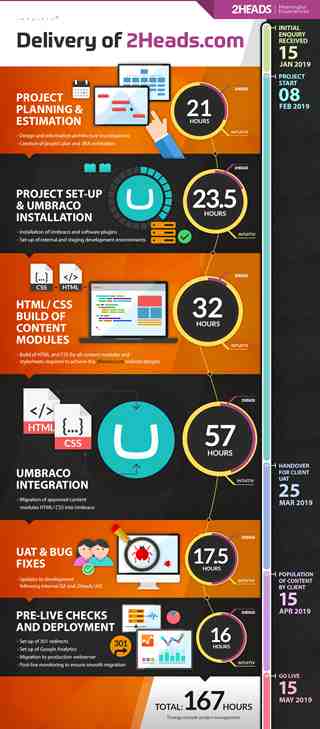Introduction
In a previous blog post, we asked “How much does it cost for a website design”, and looked at the factors and options affecting timings and therefore cost. In this article though, we get down to the nitty-gritty. We’ve used a real-life recent project to create a snazzy infographic, highlighting the stages of a typical build for a small to medium website driven by an Umbraco content management system (CMS), and how long each stage took. It flags up some crucial tasks and stages that should be included in your planning – tasks and stages that you may not have considered.
(If you’re unfamiliar with Umbraco CMS, have a quick read of our blog post “10 reasons why an Umbraco Content Management System is crucial to your business website” and our Umbraco websites services page.)
Essential timings and tasks

The project
The website was for an experiential marketing agency, 2Heads. They required a slick brochure-style website featuring video content, interactive panels and animations – all fully mobile responsive, of course.
All content needed to be completely manageable, with flexible layout options. We created a customised CMS using Umbraco. This gave 2Heads the content control they required in a highly intuitive, easy-to-use environment.
We’ve taken the timings straight from our Jira task management system. We haven’t included any design time though, as the designs were created by 2Heads’ designer. The infographic also doesn’t include project management or client liaison time as we don’t track this – we’re just always there throughout the project!
Key take away points
It’s not necessarily the actual development work that takes up most time!
-
Leave plenty of time for populating content
-
Don’t underestimate work that may be required of you as a client e.g. User Acceptance Testing (UAT), the population of content (unless otherwise agreed)
-
Don’t underestimate the time for pre-live checks, testing, deployment to test and live servers
-
Almost 25% of project time taken up by planning and pre-live checks
-
Just over 50% of time spent on actual development work
Conclusion
By breaking down projects like this (and the fact that we’ve been developing websites for over 20 years), we can be more confident in our costing and timescale estimates. And, with our experience, we’re used to spotting any potentially awkward hurdles in the project.
We hope this has highlighted some stages and timings that you may not have considered when thinking about your website project. If you’re approaching agencies for project estimates, it’s definitely worth asking about these not-so-obvious aspects of website development, so you can factor them in.
We hope this infographic will help you with your website build – from strategy and planning through to establishing launch periods.
As always, drop us a line or give us a call – advice is always free!